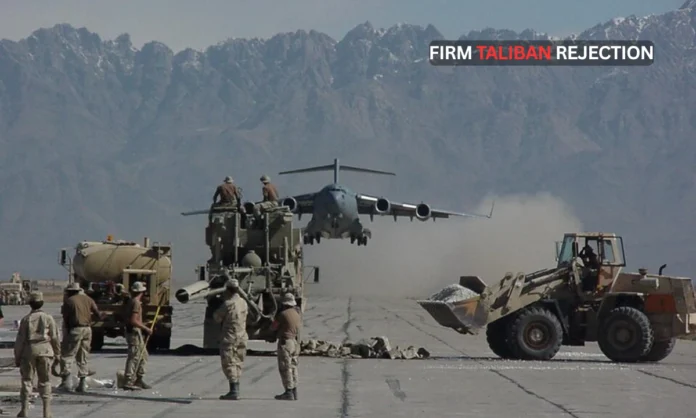Key Highlights:
- Taliban officials declared that “not even an inch” of Afghan soil will be ceded to the United States, emphasizing Afghanistan’s territorial integrity and sovereignty
- Trump publicly threatened consequences while claiming ongoing negotiations with Afghanistan about reclaiming the base, though details remain undisclosed
- The dispute centers around Bagram Air Base’s strategic proximity to China’s nuclear facilities in Xinjiang province, approximately one hour’s flight away
The Taliban government in Afghanistan has categorically refused President Donald Trump’s demand for the return of Bagram Air Base, dismissing threats of unspecified consequences from the United States. Bagram Air Base, located 60 kilometers north of Kabul in strategic Parwan province, represents Afghanistan’s largest military installation and has become the center of a major diplomatic standoff between Washington and the Taliban. The rejection comes after Trump’s public ultimatum on September 20, 2025, threatening that “bad things are going to happen” if Afghanistan does not hand over the strategic Bagram Air Base facility to American forces.
Taliban’s Uncompromising Response
Taliban spokesperson Zabihullah Mujahid issued a stern rejection of Trump’s ultimatum, urging Washington to adopt “realism and rationality” in its approach to Afghanistan. The Taliban emphasized that Afghanistan maintains an “economy-oriented foreign policy” seeking constructive relations with all nations based on mutual respect and shared interests, but firmly rejected any military presence on Afghan territory.
Fasihuddin Fitrat, chief of staff at Afghanistan’s Defense Ministry, reinforced this position during a Sunday address broadcast by local media, stating that “a deal over even an inch of Afghanistan’s soil is not possible”. The Taliban government referenced the 2020 Doha Agreement, reminding the United States of its commitment not to “use or threaten force against the territorial integrity or political independence of Afghanistan”.
The Taliban’s rejection draws on historical precedent, with Afghan officials emphasizing that “Afghans have never accepted a foreign military presence in their country” and maintaining that territorial sovereignty remains non-negotiable. This stance reflects Afghanistan’s long-standing resistance to foreign occupation throughout its modern history.

Timeline of Bagram Air Base: From Soviet Construction to Trump’s 2025 Ultimatum
Trump’s Strategic Justification and Threats
President Trump first raised the possibility of reclaiming Bagram Air Base during his state visit to the United Kingdom, subsequently escalating his rhetoric with direct threats against Afghanistan. Trump specifically highlighted the base’s strategic value, noting its proximity to China’s nuclear weapons production facilities in Xinjiang province, stating that Bagram Air Base is “just an hour away from where China develops its nuclear weapons”.
The President’s ultimatum, delivered via his Truth Social platform, declared: “If Afghanistan doesn’t give Bagram Airbase back to those that built it, the United States of America, BAD THINGS ARE GOING TO HAPPEN!!!”. When questioned by reporters about potential military action, Trump remained deliberately vague, stating “We won’t talk about that, but we’re talking now to Afghanistan, and we want it back and we want it back soon, right away”.
Trump has consistently criticized the Biden administration’s handling of the Afghanistan withdrawal, calling it “gross incompetence” and arguing that the United States essentially handed the Taliban “Bagram for nothing”. The President’s focus on Bagram Air Base reflects broader concerns about America’s strategic position in Central Asia amid rising competition with China.
Bagram’s Critical Strategic Importance
Bagram Air Base represents far more than a military installation, serving as a crucial strategic asset in Central Asia’s geopolitical landscape. Located approximately 50 kilometers north of Kabul in Parwan province, the facility was the largest American military base in Afghanistan during the 20-year conflict.
The base’s strategic significance stems primarily from its proximity to China’s expanding nuclear infrastructure in Xinjiang province, including major missile silo fields near Hami and Yumen, as well as the Lop Nur nuclear test site. Satellite imagery reveals China’s ongoing expansion of underground missile silos and nuclear testing infrastructure in this region, part of Beijing’s broader nuclear modernization efforts.

Strategic Proximity: Bagram Air Base Distance to Chinese Nuclear and Military Facilities
Originally constructed with Soviet assistance in the early 1950s and significantly expanded during the decade-long Soviet occupation, Bagram Air Base evolved into a sprawling facility resembling a small town at the height of American operations around 2010. The base featured an 11,800-foot runway capable of accommodating bombers and large cargo aircraft, along with commercial amenities including supermarkets and fast-food outlets.
Historical Context and Future Implications
The current standoff over Bagram Air Base directly contradicts the 2020 Doha Agreement negotiated during Trump’s first presidency, which mandated complete American troop withdrawal from Afghanistan. Under that agreement, the United States committed to withdrawing all forces from Afghan bases within 14 months, contingent upon Taliban counterterrorism commitments.
The chaotic American withdrawal from Bagram Air Base in July 2021 marked a pivotal moment in the conflict, with the loss of crucial air power contributing to the rapid collapse of Afghan government forces and the Taliban’s swift return to power. During the peak of American operations, approximately 100,000 US troops were stationed across more than 10 military bases throughout Afghanistan.
The Taliban’s current rejection of American demands reflects their consolidation of power and determination to maintain sovereignty over Afghan territory. Despite facing economic challenges, international legitimacy questions, and internal security threats since returning to power in 2021, the Taliban government appears unwilling to compromise on territorial integrity issues.
Final Perspective
The Taliban’s categorical rejection of Trump’s Bagram Air Base ultimatum represents a significant diplomatic impasse that highlights the complex aftermath of America’s longest war. With both sides maintaining irreconcilable positions, the dispute underscores the broader challenges facing US-Afghan relations and America’s strategic positioning in Central Asia amid intensifying great power competition with China.
The standoff over Bagram Air Base reflects deeper questions about American influence in the region and the effectiveness of military threats against a Taliban government that has successfully consolidated control over Afghan territory. As geopolitical tensions continue to escalate between Washington and Beijing, the strategic value of Central Asian military assets like Bagram Air Base will likely remain a contentious issue in international relations.


